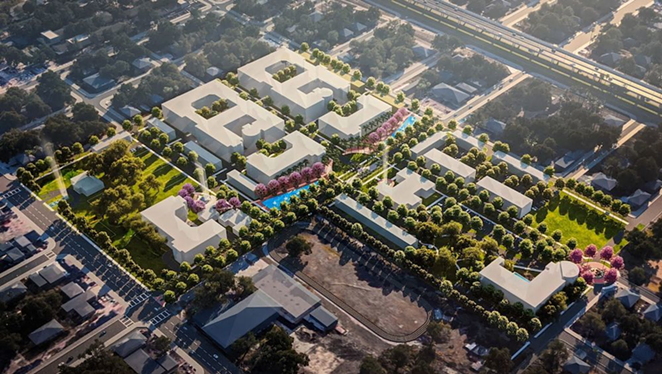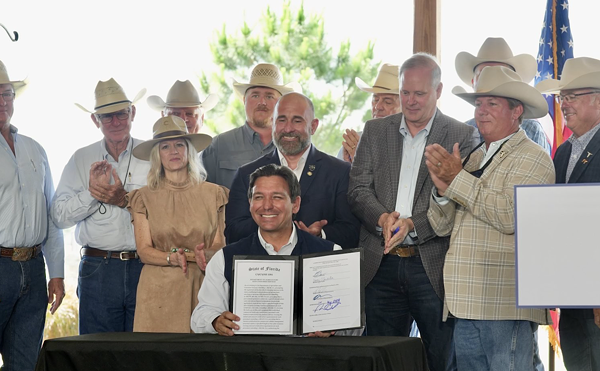
On Tuesday night, a “Robles Park redevelopment stakeholders meeting” was held at the Tampa Heights Junior Civic Association to discuss the future of the Robles Park neighborhood just a mile away.
During the meeting, planners said that only a small number of people currently living at Robles Park Village are expected to return if the housing project is demolished and redeveloped.
Planners expressed that the most likely and preferred outcome for the park is to move all of the estimated 1,000 residents out, demolish all the decrepit housing there and build “New Robles Park,” a modern, community-driven neighborhood.
The vision they proposed is that years down the road, Robles will be rebuilt as a mixed income neighborhood with a focus on affordable housing complete with a community hub to help families find access to jobs, health, education and other social services.
During the meeting, three visions for a memorial for Zion Cemetery— a historic Black cemetery that was paved over and forgotten until recently discovered—were also presented. The project is still in formation and the presentation was absent of certain key details such exactly as how the community will be funded.
A point of concern occurred when the planners—Baker Barrios Architects, and Property Markets Group, and representatives from the Tampa Housing Authority (THA)—pointed out that many of the current residents at Robles would not return, based on past community redevelopment experiences. THA said that the past return rate of people to communities that get redeveloped has been between 10-15%.
The planners estimated that Robles is home to approximately 1,000 residents. When asked if that meant just 100-150 people are estimated to return after redevelopment, planners said that figure seemed accurate but that they hope more than that return.
Members of the audience, which included about 20 people, began asking questions about where these tenants might go, if they would be relocated inside Tampa city limits, and why there’s such a low estimated return rate. To this there was no clear answer, but that some people find other opportunities.
Reva Iman, president of the Robles Park tenants association assured attendees that she was “with but not with” the planners, and that she was keeping an eye on the process.
“I’m telling you, I won’t let Robles get gentrified,” Iman said.
Planners also assured the audience that people relocated out of Robles would be placed in equitable housing but there was not a clear answer as to how many would stay in Tampa city limits.
The planners said they’ve been holding focus groups for months, and that all of the decisions being made were ultimately up to the current residents of Robles.
When CL asked the room how many people at the meeting were currently living in the Robles Park community, only Iman raised her hand.
Iman also brought up the possibility of credit and background checks when people return. This was not confirmed by any of the planners, but such a decision would be crucial to the residents who wish to return, as many low-income people often have credit problems and arrest issues.
After hearing the presentation, real estate agent Justin Ricke expressed some reservations about the THA plan for addressing affordable housing, and the “wrap-around solutions,” which entail meeting the needs of low-income renters.
“They touted intensive programs but yet to have any information on how they will consistently fund [the project] to provide future residents service,” Ricke told CL. “According to the THA, they have wrap-around solutions now, which does not really seem to be effective given the rates of return for future tenancy in the redevelopment.”
Ricke continued that there seems to be a fallacy in the project’s presentation, and says it doesn’t add up that people would have an opportunity or live in a vastly improved building, with expanded programs and amenities, and yet the return rate is expected to be only 10-15%.
“It simply does not seem accurate,” he told CL. “A big concern is that the project will not adequately address affordable housing for low income residents in Tampa Heights, but instead will push residents to far flung regions of the county where transit is not accessible and the poverty cycle will continue.”
Send anonymous news tips to [email protected]. Support local journalism in these crazy days. Our small but mighty team works tirelessly to bring you news on how coronavirus is affecting Tampa and surrounding areas. Please consider making a one time or monthly donation to help support our staff. Every little bit helps.
Subscribe to our newsletter and follow @cl_tampabay on Twitter.

















